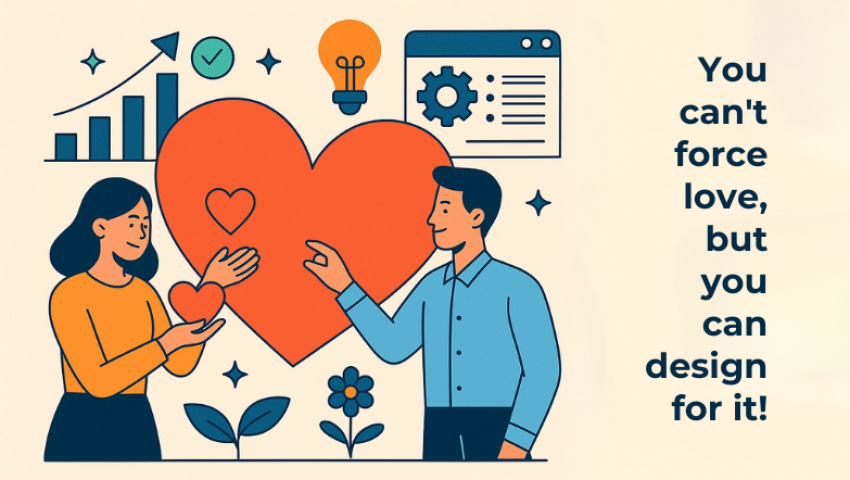
You Can’t Convince Someone To Love—But You Can Design for It: Building a Brand People Choose to Believe In
Build a business people choose to love—staff and clients alike—by aligning your culture and experience with emotional intelligence and purpose.
The Celebration That Wasn’t
The company rooftop glittered with fairy lights. A live acoustic duo strummed softly as hors d'oeuvres were passed around. A celebration of hitting annual targets, this staff party was supposed to be a triumph. Yet as the evening wore on, rows of unclaimed name tags and half-eaten desserts revealed a different story. Many employees hadn’t shown up. Some who did arrive left quickly after making a brief appearance. Despite the effort and budget spent, the event landed flat. The CEO later confided, "It felt like we were celebrating at people, not with them."
What leadership failed to grasp is that engagement isn’t about gestures—it’s about belief. Culture isn’t built in a night. It’s constructed through every conversation, every system, and every signal sent to those who make the business real.
The Limits of Transactional Engagement
Perks are plentiful in modern workspaces. From unlimited vacation policies to nap pods, companies invest heavily in engagement tactics. But the numbers tell a sobering tale. According to Gallup, only 23% of the global workforce is actively engaged. Meanwhile, Deloitte reports that nearly 70% of customers switch brands not due to price or product, but because they feel unappreciated. This points to a deep truth: loyalty—whether from employees or customers—isn’t a commodity. It’s a commitment born from emotional alignment.
Consider Google, long hailed for its enviable workplace perks. Yet in recent years, internal walkouts and protest letters have shown that ping pong tables can’t mask perceived misalignments in purpose and policy. Similarly, United Airlines' infamous 2017 scandal, where a paying passenger was forcibly removed from a flight, demonstrated that operational efficiency without empathy can quickly erode decades of brand equity. These incidents aren’t anomalies; they’re cautionary tales. The emotional contract between companies and their stakeholders is fragile—and it must be honored consistently.
In the industrial age, companies scaled through efficiency. In the information age, they scaled through innovation. But in today’s trust economy, they scale through meaning. The historical arc is clear: as systems become smarter, people demand smarter relationships with brands and employers. Emotional alignment is the new productivity multiplier. Consider Patagonia, which became a $3B brand not just through products, but through purpose-led authenticity that employees and customers alike rally behind.
Love is Strategic. And Measurable.
At Maldicore, we work from a radical premise: that belief can be designed. We do not offer feel-good slogans or temporary morale boosters. Instead, we embed emotional intelligence into the infrastructure of business. Our proprietary tools—from VisionSync Sessions™ to our Core Impact Framework™—equip leaders to surface, align, and scale belief across every touchpoint.
ESG investing, stakeholder capitalism, and reputation-driven valuation are reshaping boardroom priorities. BlackRock’s Larry Fink famously stated that “profits and purpose are inextricably linked.” Companies with high-trust cultures outperform on shareholder return, suffer fewer PR crises, and attract higher-quality talent. Emotional strategy isn’t soft. It’s a risk hedge, an innovation enabler, and a brand asset.
Take, for instance, our work with a mid-sized marketing company. Leadership wanted faster tech adoption. But through Stakeholder Interviews and the Discovery Canvas, we uncovered a deeper issue: frontline staff felt decisions were being made above them, for them. Using our Execution Canvas, we co-created new rituals of recognition, redesigned KPIs with team input, and restructured decision loops to be participatory. Attrition dropped by 26% and cross-functional initiative participation surged. The culture shifted from compliance to commitment.
Another example comes from the tourism industry. A premium travel brand struggled with declining repeat bookings. Marketing campaigns promised luxury; operations struggled to deliver. Through Friction Mapping and Business Model Alignment, we revealed a trust gap. Marketing and operations were operating on different definitions of quality. We brought them into a shared VisionSync Session and co-created a deliverable brand promise rooted in real capabilities. Within three months, repeat bookings increased by 31%.
These cases reflect a simple truth: love cannot be imposed, but it can be invited through systems that honor transparency, co-creation, and truth.
Rewriting the Script of Engagement
One of the fastest ways to assess a culture is to listen. Not to the formal mission statement, but to the hallway chatter, internal emails, and onboarding materials. Language is culture's delivery mechanism. At Maldicore, we run Language Audits as part of our BrandCore Decode™ and Execution Canvas. We examine the words teams use every day—because those words create belief, or break it.
Consider these common phrases and their alternatives:
- “We need buy-in from staff” becomes “Let’s co-design this with the team.”
- “We’re like a family” shifts to “We’re a professional team that wins through trust.”
- “That’s just policy” becomes “Let’s revisit why this rule exists.”
- “The customer is always right” turns into “Let’s understand what the customer is actually feeling.”
These micro-swaps shift emotional posture from control to care. From rigidity to reflection. They are small, but they are tectonic.
A System for Building Belief
Our frameworks form the structural core of how we help companies transition from transactional to transformational. Each one addresses a specific phase of the journey—from uncovering emotional truths to operationalizing change.
VisionSync™ aligns leadership intent with employee and customer expectations, creating a unified emotional compass.
BrandCore Decode™ extracts the authentic brand DNA and translates it into language and imagery that resonates both internally and externally.
Discovery Canvas maps hidden beliefs, emotional triggers, and behavioral patterns through qualitative immersion.
Diagnosis Canvas identifies cultural frictions, trust gaps, and the misalignment between intent and perception.
Strategy Canvas builds a prioritized roadmap to move from current state to an emotionally resonant future state.
Execution Canvas transforms strategy into rituals, systems, and messages that shape behavior.
Growth Loop Canvas closes the loop by integrating ongoing feedback into adaptive culture models.
A System for Building Belief
Our frameworks form the structural core of how we guide companies transition from transactional to transformational. Each one addresses a specific phase of the journey—from uncovering emotional truths to operationalizing change.
- VisionSync™ aligns leadership intent with employee and customer expectations, creating a unified emotional compass.
- BrandCore Decode™ extracts the authentic brand DNA and translates it into language and imagery that resonates both internally and externally.
- Discovery Canvas maps hidden beliefs, emotional triggers, and behavioral patterns through qualitative immersion.
- Diagnosis Canvas identifies cultural frictions, trust gaps, and the misalignment between intent and perception.
- Strategy Canvas builds a prioritized roadmap to move from current state to an emotionally resonant future state.
- Execution Canvas transforms strategy into rituals, systems, and messages that shape behavior.
- Growth Loop Canvas closes the loop by integrating ongoing feedback into adaptive culture models.
This system doesn’t just generate insights—it sustains momentum. It transforms companies into places of purpose, clarity, and credibility.
When Love Becomes Leverage
Designing for belief is not only moral—it’s measurable. At Maldicore, we track key outcomes across five categories: culture alignment, execution velocity, engagement retention, trust score (internal NPS), and customer return rate.
Across clients using our integrated frameworks:
- Culture alignment improves by 38% (measured via Diagnostic Canvas benchmarks).
- Execution velocity increases by 22% on cross-functional projects.
- Staff engagement rises by 41% within the first 90 days post-implementation.
- Trust scores (internal and external) increase by 44%.
- Margins improve by 7-12% in high-trust, low-friction teams.
These are not outliers. They are the natural consequence of businesses choosing to become emotionally coherent.
Are You Worth Loving?
There is no greater competitive advantage than being a company people choose to believe in. Not because of coercion or convenience, but because of coherence—between what you say, what you do, and how people feel inside your ecosystem.
So ask yourself, as we ask our clients:
Is your business worth loving—by the people who build it, and by the people who buy from it?
If you hesitate, that’s the beginning of a conversation. Because the moment you stop trying to convince and start designing for connection, belief starts to take root.
Talk to Maldicore. We don’t manufacture loyalty. We architect belief.

Maldicore Support
Leave a comment
Your email address will not be published. Required fields are marked *

